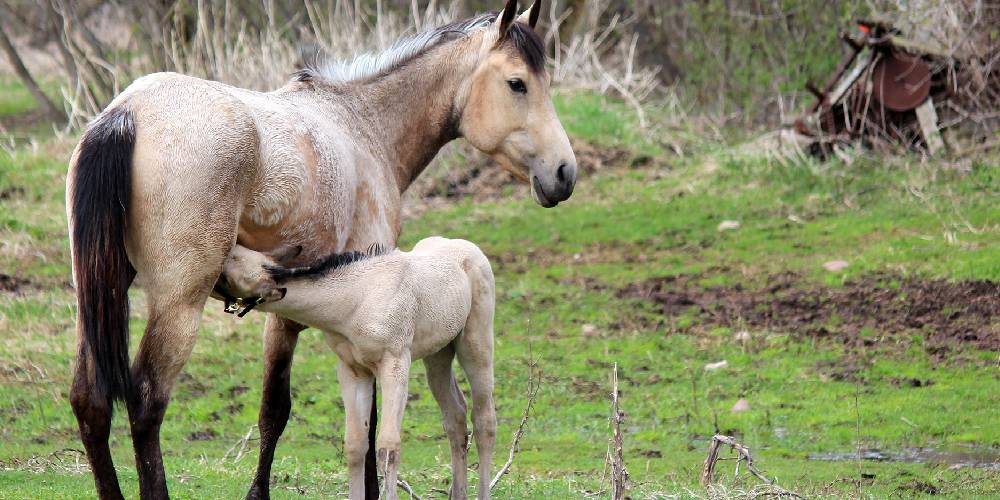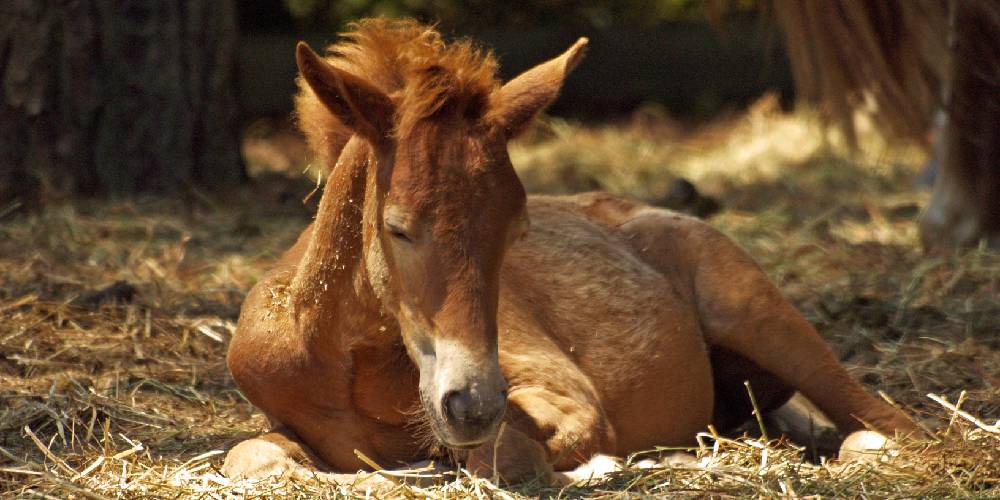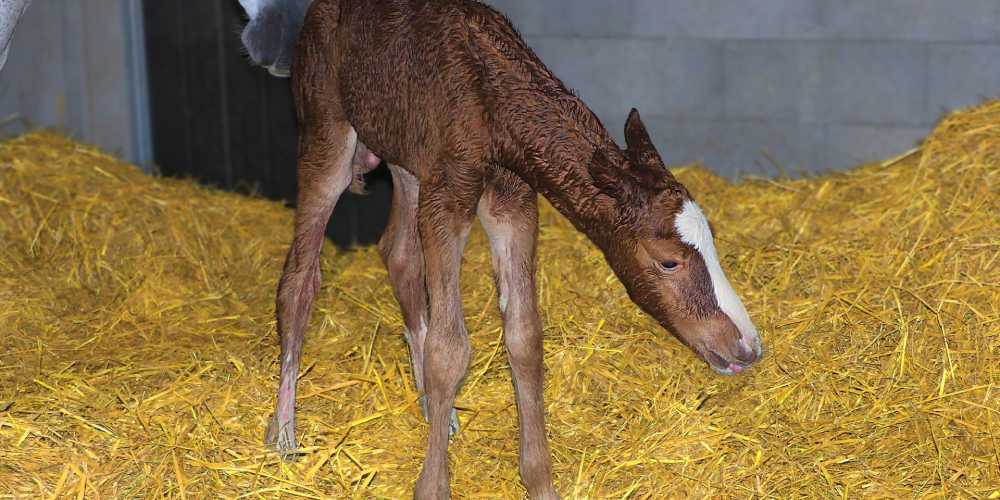Is your mare expecting? This can be a super exciting time as a horse owner, knowing that a little one is on the way, but it can also be a time of great nerves and stress! You might be saying to yourself, “How on earth do you take care of a foal?” or “How do I prepare myself for this big step as a horse owner?”
If this is you, take a deep breath. I put together this post with the intention of helping all you horse owners with expecting mares get a better idea of how to approach this next phase of your horse-owning career. One of the big steps you need to take to prepare you and your horse for foaling is putting together your foaling stall.
This article will break down the steps to take to best prepare your mare’s stall for the big day! I will cover:
- Checking your mare’s stall for hazards
- Cleaning the foaling stall
- Bedding the foaling stall
- Things to have on hand for the birth
- Making mama horse comfortable before her delivery
- When to prepare the foaling stall
Take a Deep Breath…

If you are anything like me, you probably have a million fears and worries zooming through your mind at the thought of your mare giving birth. But, if your mare is healthy, she is in a spacious, well-bedded, and clean stall, and she hasn’t had any pregnancy complications, then really, there is no need to freak out.
Mares in the wild give birth to foals all the time all on their own. In reality, you may not have to do much of anything during the birth process. Sometimes the best thing you can do is just let nature take its course!
Though 99.9% of the time, there aren’t any complications or issues with the birth process, it is a good idea to prepare yourself for anything. Don’t stress, but also be prepared for any and all possible outcomes.
Knowing how to prepare a birthing stall for your mare is a great place to start when it comes to preparing yourself and your horse for the big day ahead!
Prepping for the Big Day…

You may be wondering, “What do I need to do to prepare myself and my mare for the birth?”
Having this question is totally normal! It can be hard to know how to prepare for something so big and so new! Here are the most important things you can prepare to ensure a safe and comfortable delivery for your mare:
Check her stall for any hazards

With a newborn on the way, you want to make sure that your mare is in a safe, hazard-free environment for birthing. One of the things you can do to ensure the safety of your mare and her foal is to check her stall for any hazards. If you thought adult horses were curious, just wait until you meet the little one on the way! Securing the stall and making sure the following hazards have been eliminated will help keep even the most curius little guy safe from harm. Some things to look for include:
- Loose boards
- Splinters
- Sharp edges
- Gaps where a little guy could find themselves stuck
- Protruding nails/bolts/screws
- Manure forks
- Latches
- Hooks
- Wires
- etc.
Keeping your mare’s stall free from the above hazards can be a game changer when it comes to the safety of the birth, and the safety of the foals few weeks of life. Eliminating things that a curious baby could find themselves snagged, stuck, or cut on will help to make sure your bouncing baby is free from any environment-related injury.
Cleaning the Foaling Stall

If you have ever been to a hospital where human babies are born, you will probably notice that the rooms are made sterile for the delivery, and everything is kept very neat, clean and organized. The stall in which your mare will be foaling should sort of be treated as her own little hospital room.
Assuming you aren’t sending your horse to a foaling center, there are a few things to do to ensure your mare is in the best foaling environment possible.
When it comes time for foaling, ensure your mare’s stall has been thoroughly cleaned and disinfected. You may want to take this time to:
- Scrub and disinfect the stall walls
- Scrub and disinfect the bars of her stall
- Clean her stall mats thoroughly
- Completely strip and re-bed her stall
Taking the above steps to prepare the foaling stall will ensure your new bundle of joy is delivered into a clean, dry, and comfortable environment.
Is there a Specific Cleaning Product I Should Use for Cleaning my Horse’s Stall?
For disinfecting and cleaning the foaling stall, there are many products that are perfectly safe to use, but there are also a few different products that can be harmful to your horse and that are better to avoid. In other words, don’t just march on in with your bleach and start spraying it everywhere! Make sure the cleaning solution you are using is in fact safe for both mama and baby to be around!
– Cleaning Solutions to AVOID:
- Scented Cleaning Detergents
- Straight Bleach
- Glass Cleaners
– RECOMMENDED Cleaning Solutions
- Surgical Scrub
- Non-Toxic Dish Soap
- Properly Diluted Bleach Solutions
- Natural/Non-Toxic Soaps
- Water!
Remember, your mare’s stall should not be reeking of bleach and Lysol when you’re done with your clean! Using unscented, non-toxic soaps and cleaning solutions will do a perfectly good job of disinfecting and cleaning your stall, no special scents necessary!
Note: If you plan to disinfect your mare’s stall with bleach, make sure it is diluted to a safe level and that any extra-bleachy areas have been rinsed thoroughly with water. The last thing you want is your mare or foal to react or become irritated to the scent of the cleaning solutions, or even ingesting it!
Bedding the Foaling Stall

What Type of Bedding Should I Use in my Mare’s Birthing Stall?
There is a lot of debate on how to best prepare and bed a stall for delivery. The main issue is the controvery surrounding the type of bedding used in the stall.
I personally am a shavings person and when I need to get bedding for my horses, I always jump to the classic pine shavings. Using shavings in your mare and foal’s stall is 100% okay! But I don’t recommend shavings for the birth itself.
After researching the pros and cons of a great number of different bedding types, I found that the best bedding for the foal delivery is straw.
The main reason I suggest using straw over pine shavings for the birth is this:
Your foal will be born very wet and slimy and covered in amniotic fluid. Shavings have the tendancy to stick to moisture and the main concern of having a wet slimy baby delivered into a thick bed of shavings is how much of the bedding will stick to their coat and possibly even getting into their ears and nose.
Having your mare’s stall bedded with straw will keep the bedding from sticking to your baby’s coat and prevent it from getting into their eyes and nose. The last thing you need is your new baby breathing in their shavings and getting a respiratory infection from accidentally inhaling their bedding!
If you really really don’t like straw (I am with those of you who don’t like it much haha) you can safely return your mare’s bedding back to pine shavings after about 3 days.
How Much Bedding Do I Need to Put in my Mare’s Stall?
Typically, in a fully bedded stall, 6-8 inches of bedding is pretty standard. Because your mare is giving birth however, I recommend increasing the depth of bedding to around 10-12 inches deep. This is to ensure baby and mama have a nice soft bed to lie on while sleeping off the tiring birth.
Things to Look Out for When Purchasing Straw Bedding:
One of the biggest things to look out for when purchasing straw bedding is mold.
In many cases, feed stores and stock shops won’t have a 100% dry or weather proof structure for storing hay and straw. Because of this, mold can start to grow if the bales of straw became wet in transport or storage.
When purchasing straw bedding, especially for an expectant mare, be sure to inspect the bales of straw before taking them to your barn. You don’t want to have mama or baby breathing in all those yucky mold spores!
How to Bed a Stall with Straw:
For those of you who aren’t familiar with straw bedding, it is a lot different than your classic pine shavings. Shavings are nice because you can just dump them in and spread them around, but using straw can be a little bit more of a process.
When bedding a stall with straw, you will first want to cut open your bale of straw and use 1-2 flakes for starters. When being baled, the straw is often compacted and pressed together so you will need to break it apart and fluff it up in order to make the straw softer and more comfortable to lie on.
Take the first couple flakes you pulled off of your bale and break them apart. You can use a pitchfork or manure fork to make the process a little easier. Sometimes, tossing the straw up in the air can help it to fluff up and break apart easier.
Break apart 1-2 flakes of straw at a time and continue adding more and more straw until you are satisfied with the depth and softness of the stall’s bedding.
Things to Have on Hand for the Birth

Part of preparing your mare’s foaling stall is preparing a birth kit to have on the side in case you need anything in it!
I recommend using a large storage tote or empty tack trunk to store anything you might need for the birth. Keep this container outside of your mare’s stall so you can have everything readily accessible in case you need anything from inside.
What Should I have in my Birth Kit?
These are some of the most helpful must-haves to put in your mare’s birth kit:
- Vet wrap or tail bag (you might want to wrap her tail up and get it out of the way so it doesn’t get any of those yucky birth juices or blood on it)
- Flashlights, lanterns, or headlamps (most mares birth at night, so having an extra light source can be helpful so you can see what you’re doing!)
- Thermometer (In case you need to check on mama’s or baby’s temperatures after birth)
- Notebook/Pen (You may want to keep track of the time, temperatures, observations, or questions you may have)
- Scissors (You may need a pair of scissors to cut the vet wrap when wrapping your mare’s tail, the amniotic sac if baby needs help escaping, or for anything else that may need cutting!)
- Hand Sanitizer (Remember! You’re dealing with a new mama and a brand new baby. Reducing the amount of germs will be helpful in keeping everyone safe and healthy)
- Old but clean towels (Sometimes birth can be super tough on mama and she may need help drying off her new baby! Towels are a life saver, especially if baby is born on a cold night! Use towels that are clean but also ones you don’t mind getting a little blood and amniotic fluid on)
- Gloves (Sometimes you may need to help mama with the birth or you might need to handle the amniotic sac! Keep your hands clean and dry with some good ol’ powder free surgical gloves)
- Navel Cleaner (Your new foal will have an open navel post-birth and sterilizing this can greatly decrease the chances of infection. Use Iodine or 2% chlorhexidine solution! Iodine based surgical scrub can also do the trick!)
- Phone Charger (If you are pulling an all nighter at the barn, having a phone charger is crucial! You may want to call your vet if there are any complications, so having a charged phone is very important!)
- Fly Spray (If your mare is having a spring or summer baby, having some fly spray on hand can be really helpful in keeping those pesky flies away)
These are some of the most helpful things you can have on hand in your birth kit! I also recommend coming up with a birth plan with your veterinarian as well. Getting their opinion and thoughts on a birth plan as well can be very helpful to ensure you are prepared for anything going into this birth!
Making Mama Horse Comfortable Before Her Delivery

I’m sure you want your horse to be as happy and comfortable as possible in those last few days leading up to the birth of her foal. There are a few things you can add to her stall to help ensure her comfort. Some of the things I recommend adding to the pregnant mare’s stall include:
- Extra Water Bucket
It can be a lot of work growing a whole baby for 11 months, so hydration is crucial! To make sure your expectant mare is staying hydrated, try adding an extra water bucket to her stall so she has more than one water source.
Keeping the extra water bucket in her stall after birth is important too! With your mare nursing a baby, she’s going to need a lot of water in order to stay hydrated while producing milk for her little one.
- Deep Bedding
Like I mentioned above, offering extra deep bedding to your mare will help her to be more comfortable in the days and weeks leading up to her birth. Horses give birth lying down (typically) and having a nice comfy bed to lie on will make her that much more comfortable!
Foals, like human babies, will sleep A LOT. Having that extra deep bedding down may also be necessary for after the birth too!
- Fan
If your mare is giving birth in spring or summer, sometimes the heat can be a little unbearable (especially if you live in Arizona like I do). Giving her access to a fan during the day can help keep mama horse cool and comfortable.
- Extra Feed
Your mare is developing a whole other horse in there! Feeding her a little extra hay and grain not only will make your hungry horse happy, but it will ensure that baby will be getting all the extra nutrients they need to finish growing and developing.
When Should I Prepare and Clean the Foaling Stall?

Mares are pregnant for around 11 months, which equals out to be between 315-380 days depending on the mare. This means, that in those last few weeks, you may want to start getting a birth kit together, a baby camera up, and stock up on extra bedding.
What I recommend doing, assuming your barn has an extra stall available, is keep your mare in her usual stall until she starts showing signs that she could give birth soon (swollen udder, dripping milk, etc.). Once she starts showing signs that indicate baby will come within the next few days, I would switch her into the sterile, deeply bedded stall for her birth. This way, you don’t need to worry about taking her out, sterilizing and cleaning her stall, only for baby not to come for a while later.
I would say that sterilizing and getting the stall bedded should be done around a week or two before your mare’s expected due date. This way, the stall is ready in case she goes into labor a little early.

